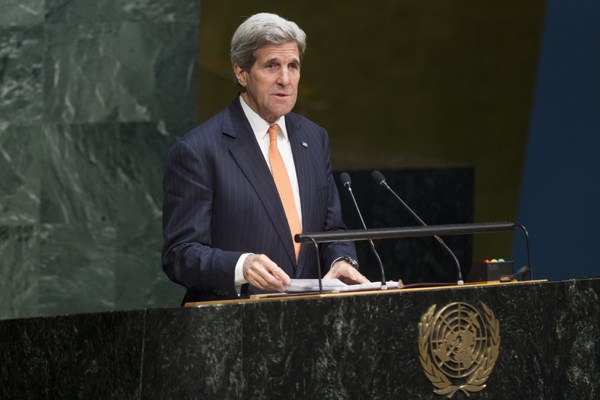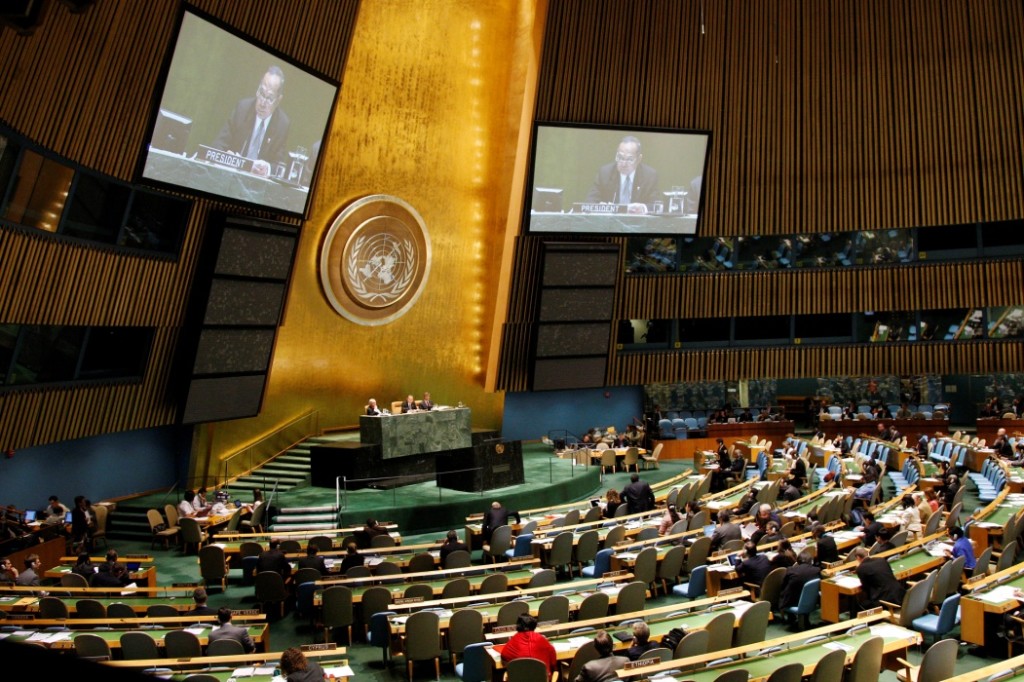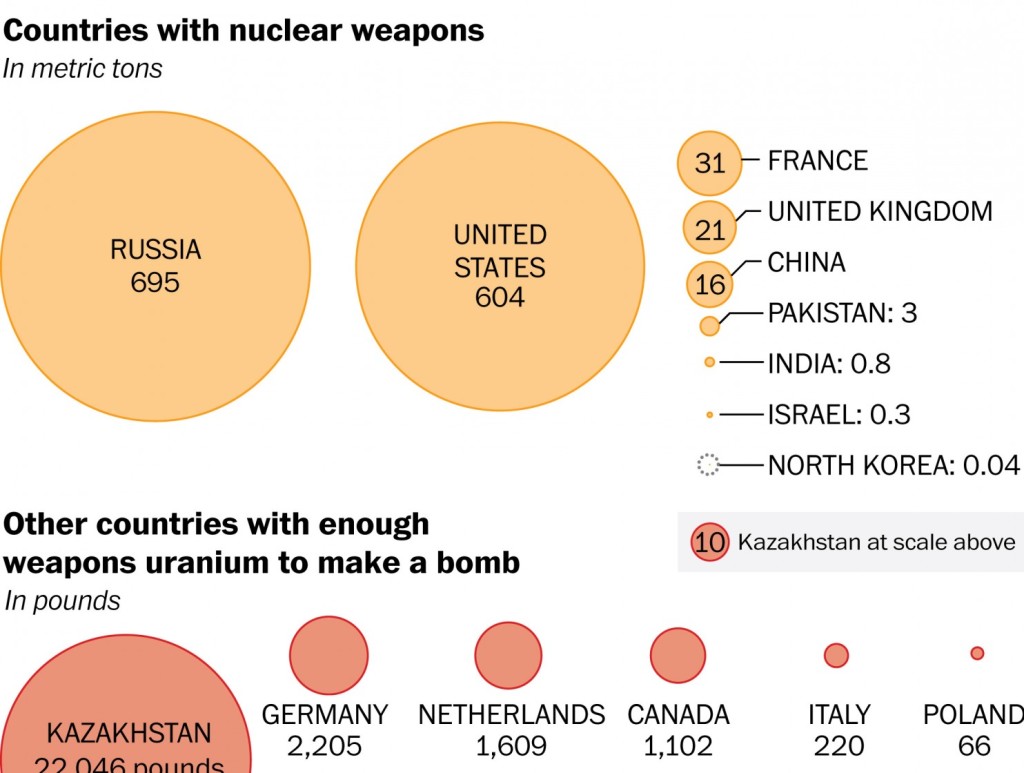The nuclear threat environment is recharging to produce a new era. A multiple nation realignment and force modernization are producing elements of a new Cold War. Entangling alliances are developing. Next-generation nuclear weapons are in development — ‘smarter’, more deliverable, and usable
This week through May 22, the United Nations headquarters in New York is hosting the ninth five-year Review Conference (RevCon) of the Parties to the Treaty on the Nonproliferation of Nuclear Arms (NPT).
The occasion demands a strategic review of the current state of nuclear weapons, the status of nuclear agreements, the future of nuclear weapons development and deployment. The risks of catastrophic nuclear war, the use of nuclear weapons in a strategic or tactical exchange, remain all-too-real. The de-escalation of Cold War US-Soviet Mutually Assured Destruction (MAD) policies, and accompanying series of nuclear weapons disarmament, control and monitoring agreements, is giving way to re-escalation.
This week the US Congress moved to approve a “new nuclear arms race” and the next-generation of “modernized nuclear weapons” is underway.
A new era of ‘smart’ nuclear weapons and nuclear weapons modernization policies are carried-forward within a framework of “high alert“, “fire on-warning” policies of the Cold War. The mix of billions in planned new nuclear spending and development will deliver a new and potentially more deadly nuclear order.
The entry of China as a major nuclear weapon player developing its own ‘triad’ of nuclear delivery systems, the mutual defense relations being pursued between nuclear weapon nations, the race to modernize and react to other nations nuclear modernization including Russia, China, India and Pakistan. The latest nuclear arsenal questions regarding North Korea bring warnings of an “arsenal” and Israel and Iran tensions in the Mideast continue as diplomatic negotiations are railed against by US political opponents. All this must give pause to any rationale discourse of security being a function of nuclear weapons modernization and proliferation.
The paucity of discussion/debate and even awareness of what is being funded, what is in the pipeline of many countries (as we at Strategic Demands have been documenting) is another warning of a nuclear threat environment that is re-casting Cold War risks of flash point, mistakes, provocations, and nuclear exchange.
Let’s look at the RevCon meeting over the next month, beginning with an initial survey of several revealing pieces from the few sources who are tracking the increased nuclear threat.
-=-=-=-=-=-=-=-=-=-=-=-=-=-=-=-=-=-=-=-=-
Via the Washington Post / by Walter Pincus
At a time of tight defense budgets, why does the Air Force plan to spend billions of extra dollars so that a president 10 or more years from now can have two options if he or she wants to use bombers to attack an enemy with nuclear weapons?
… Think about that.
That future president would have the option to employ the planned, manned or perhaps unmanned long-range strike bomber (LRSB) to drop B61-12 nuclear bombs, both of which are now in development.
The proposed cost of 80 to 100 new LRSBs, at about $550 million each, could exceed $55 billion, although not all of it would be for the nuclear mission. The cost of development and production of a new B61 bomb is estimated at $10 billion, although some money would be allocated to fighter bombers attached to NATO…
Arms control treaties between Moscow and Washington brought those numbers down. But the move by both countries to modernize their nuclear-capable long-range cruise missiles and bombers actually lets them take advantage of a loophole in the 2010 New Strategic Arms Reduction Treaty…
On April 5, 2009, in Prague, President Obama set a goal of “a world without nuclear weapons” and got great applause. But then Obama added, “I’m not naive. This goal will not be reached quickly — perhaps not in my lifetime.”
The Senate ratified the new arms treaty on Dec. 22, 2010, but to get Republican votes for the two-thirds majority needed, Obama had to promise to modernize the American nuclear weapons complex and the nuclear delivery systems.
The treaty may have been a step forward to Obama’s goal of a weapons-free world, but the price he paid has turned out to be two steps backward.
-=-=-=-=-=-=-=-=-=-=-=-=-=-=-=-=-=-=-=-=-
“The worldwide modernization craze scrambles the calculus of nuclear disarmament and nonproliferation efforts, challenging the aging underpinnings of the NPT itself,” writes John Mecklin for Foreign Policy. “Unless the United States, Russia, and other powers find a way to agree on reining in their modernization programs, the world’s non-nuclear countries will have increasingly legitimate reasons to ask how they benefit from being part of the NPT—and why they shouldn’t go their own way.”
Via Foreign Policy / by John Mecklin
DISARM AND MODERNIZE
In terms of warhead numbers, the nuclear arms race may be over. But massive weapons upgrades now underway challenge the entire disarmament regime.
BY JOHN MECKLIN
“In terms of warhead numbers, the nuclear arms race may be over. But massive weapons upgrades now underway challenge the entire disarmament regime.”
the early decades of the Cold War, NATO made arrangements to bury what were known as atomic demolition munitions (in essence, nuclear mines) at key points in West Germany, to be detonated if Warsaw Pact forces ever invaded. Although this plan, if enacted, might have slowed the enemy advance, it also almost certainly would have turned vast West German territories into radioactive wastelands littered with corpses and smoldering buildings—the stuff of hellish alternative- history scenarios. The West viewed such tactical nukes—NATO fielded 7,000 to 8,000 of these shorter- range, smaller-yield weapons for most of the Cold War—as tripwires in anticipation of the Soviet Union’s own Strangelovian plans for its thousands of tactical weapons. That is to say, the forward positioning of these nukes was a signal: If the Soviet Union invaded Europe, confrontation would escalate quickly to the nuclear realm, and the United States would intervene.
With the end of the Cold War and the reduced risk of a Russian invasion, NATO eliminated almost all its tactical nuclear weapons in Europe. Today, five NATO countries—Belgium, the Netherlands, Germany, Italy, and Turkey—are widely believed to host roughly 200 U.S.-owned nuclear bombs at their air bases. These weapons, variants of the B61 warhead, a stalwart of the American thermonuclear arsenal since the late 1960s, are viewed by some security experts as provocative anachronisms. The critics argue that strategic missiles and bombers posted in the United States and the United Kingdom, along with missiles on nuclear submarines, provide more than enough deterrence against any Russian aggression.
But in the wake of Russia’s annexation of Crimea and the destabilization of Ukraine, the controversy about B61s is being heightened and compounded. In addition to retaining tactical nukes in Europe, the United States plans to modernize the weapons, as well as its arsenal back home, in a remarkably expensive way. This decision has inflamed debate about the depth of the U.S. commitment to the Nuclear Non- Proliferation Treaty (NPT), which allows the United States, Russia, China, the United Kingdom, and France to have nuclear weapons if they promise to eventually disarm.
Today, weapons innovation threatens to become the new mode for arms competition. Washington’s upgrading of the B61-4 bomb, for example, would equip the device with a tail assembly, making it into a precision-guided standoff weapon. An irony is attached to this redesigned device, called the B61-12: It would be able to attack the same targets as previous gravity bombs in the U.S. arsenal, but would do so more accurately and efficiently, using smaller yields that would create less collateral damage and less radioactive fallout. This means the bombs might be seen as more conceivably usable in a limited or tactical conflict. And this is precisely why the U.S. Congress rejected the Air Force’s requests for low-yield, precision-guided nuclear weapons in the 1990s: Their very accuracy increases the temptation to use them.
Nonetheless, under current plans, approximately 480 B61-12s are set to be produced by the mid-2020s, and they would serve all U.S. gravity-bomb missions contemplated for five different aircraft. In addition to deployment in Europe, the U.S. Air Force also intends to use the B61-12 to arm heavy B-2 and B-52 bombers based in America. Even by the standards of defense budgets, the B61 modernization program is exorbitant: Estimates place its ultimate cost north of $10 billion, or more than if the bombs were constructed of solid gold.
But the high cost and questionable utility of the B61 program are not anomalies—nor is the fact that the plan has received little publicity.
-=-=-=-=-=-=-=-=-=-=-=-=-=-=-=-=-=-=-=-=-
Via Reaching Critical Will
2015 NPT Review Conference Briefing Book
The 2015 Review Conference of the Parties to the Treaty on the Non-Proliferation of Nuclear Weapons (NPT) will meet 27 April–22 May 2015 in New York. This Review Conference marks the end of a five-year review cycle.
Background The NPT Action Plan, adopted at the 2010 NPT Review Conference, was considered an accomplishment at the time. Five years later, however, its partial implementation and relevance for future action must be carefully considered. The 2010 Action Plan is the latest in a series of agreements reached by NPT states parties over the past decades, including the 1995 principles and objectives, the 1995 resolution on the Middle East, and the 13 practical steps from 2000. None of these agreements have yet been fully implemented. Article VI of the NPT, requiring nuclear disarmament, remains unfulfilled, even as the Treaty’s non-proliferation requirements are met and strengthened. The 64 actions of the Action Plan contain provisions on nuclear disarmament (22 actions), nuclear non-proliferation (23 actions), and nuclear energy (18 actions)…
Differing views on the timeframe within which the implementation of the Action Plan should be completed have emerged. In the lead up to the 2015 Review Conference, some states parties stress that the 2010 Action Plan should be seen as a longterm roadmap. But most states parties do not agree with this retrogressive approach and still see it as a short-term plan that was intended to move states parties closer to full implementation of all Treaty provisions over a specified time frame. Failure to implement those actions within this time frame does not justify their indefinite extension, but rather, should serve as a catalyst for developing new approaches and initiatives to achieve the Treaty’s objectives. Current situation Implementation of actions across the three pillars varies greatly, therefore it cannot be considered adequately implemented. According to our 2015 NPT Action Plan Monitoring Report, only 28 out of the 64 actions can be considered fully implemented in 2015. 21 actions are being implemented to some degree and 15 actions cannot be considered implemented at all. Most progress has been achieved on the actions dealing with nuclear energy, while those on disarmament lag far behind.
○
Assured destruction / 2015 edition
This updated study explores the ongoing and planned nuclear weapon modernization programmes in China, France, India, Israel, Pakistan, Russian Federation, the United Kingdom, and the United States.
As of April 2015, the nuclear-armed states are estimated to possess approximately 15,650 nuclear weapons. All of them have plans to modernise—upgrade and / or extend the lives of—their nuclear weapons. In Assuring destruction forever: 2015 edition, non-governmental researchers and analysts provide information on each country’s modernisation plans.
○
US Nuclear Weapons Modernization
The United States is conducting a complete overhaul of all components of its nuclear triad, requiring three full decades of investment. This will cost, including current operations, at least $1 trillion. The new weapons and factories placed into service will last, i.e. generate nuclear threats (their purpose), until late in this century. US nuclear modernisation is already producing significant new nuclear capabilities with unknowable consequences, and significant additional new capabilities are planned and budgeted. No warhead retirements are occurring under New START and none are committed. Future dismantlements have been made contingent on construction of new factories and deployment of new weapons. The modernisation programme-of-record has been dogged by delays, cancellations, downscaling, and cost overruns; its completion in an era of budgetary uncertainty and constraint is widely questioned. Modernisation competes with warhead dismantlement for scarce physical and financial resources in the production complex. There are deep concerns in government (including the military) and in civil society about nuclear weapons cost and relevance, but so far not one member of Congress publicly opposes maintaining a policy of “mutual assured destruction” (MAD) based on a triad of delivery systems with thousands of nuclear warheads.
US Nuclear Weapons ‘Modernisation’ by Greg and Trisha Mello / Los Alamos Study Group
-=-=-=-=-=-=-=-=-=-=-=-=-=-=-=-=-=-=-=-=-=-=-=-=-=-=-=-=-=-=-
Nuclear NPT Review Conference
News:
Opening day speakers
Non-Aligned Movement – Javad Zarif, Foreign Minister Iran, Full Text of Opening Statement
Kerry says Iran, World Powers Closer than Ever to a Historic Nuclear Deal / Reuters
Kerry: Closer Than Ever to Historic Iran Deal / Al Arabiya-Reuters
“Quotable Quotes” from the NPT Conference / China News
○
Putin: Russia Cuts Nuclear Arms Stockpiles to Minimal Level / Interfax
New Technologies Complicate U.S.-Russia-China Arms Control
○
Press/Wire Service Reports:
Iran aims to use NPT conference to renew international pressure on Israel / Jerusalem to attend non-proliferation meet for first time in 20 years; Iran FM at opening of conference: ‘Israel is the single [worst] violator of this international regime [the NPT]’ / Haaretz
After failing to preempt: Israel, Iran and nuclear war / Jerusalem Post
○
Nuke-armed states not eliminating stockpiles: Iran
Nuclear disarmament NAM’s highest priority: Zarif
NEW YORK, Apr. 28 (MNA) – Highlighting the nuclear disarmament, Iranian Foreign Minister Mohammad Jvad Zarif delivered a speech in 2015 NPT Review Conference and deemed nuclear weapons the greatest threat to humanity.
_________________________________________
Analysis/Opinion/Social Media:
United Nations NPT Review Conference
Speakers List at the 2015 Review Conference
TREATY ON THE NON-PROLIFERATION OF NUCLEAR WEAPONS (NPT)
International Atomic Energy Agency
○
US State Department Statements/Positions re: NPT Review Conference
Rough Seas Ahead: Issues for the 2015 NPT Review Conference
Armes Nucleaires – Review and Proposals
International Campaign to Abolish Nuclear Weapons
ICAN 424 NGOs 95 countries – NPT RevCon Briefing Materials – Nuclear Weapons by Country
Review of 2010 Final Document of NPT RevCon and Challenges to 2015 Conference
Review of 2010 and Obama/US NPT initiatives / India perspective
○
ian bremmer @ianbremmer
Geopolitics in 3 Steps
Cold War: Stable, Dangerous
Post-Cold War: Unstable, Not So Dangerous
G-Zero: Unstable, Dangerous
○
Eco-Nuclear Issues Religious Summit (April 28):
‘Global Movement across All Religions to Protect the Environment’
Catholics to Press Nuclear Weapons Ban
Catholic Church Formulates a New Policy on Ethics of Nuclear Deterrence
○
Nuclear Weapon System Modernization, New Multilateral Era
New Technologies Complicate U.S.-Russia-China Arms Control
Is China Preparing MIRVed Ballistic Missiles?
China’s Nuclear Weapons Modernization
China Moving to Assured Retaliation
No longer a No “First Strike” Policy? China’s Defense Policy?
http://www.nti.org/country-profiles/china/
Russia and America Stumbling to War / May-June 2015
Most dangerous are disagreements over the international system and the prerogatives of major powers in their immediate neighborhoods—disputes of the sort that have historically produced the greatest conflicts. And these are at the core of U.S. and Western tensions with Russia and, even more ominously, with China.
○
StratDem Archive — Nuclear Escalation
https://strategicdemands.com/blip_on_the_screen/
https://strategicdemands.com/going_bzhrk/
https://strategicdemands.com/wartimes-arms-salesarms-race/
○
US Gears Up for Potential War in Space / April 2015
Air Force Space Command Commander Gen. John Hyten said during a press conference, “We have a responsibility to defend against all threats. That’s what our job is. … There is no doubt we have seen threats appear in the last decade, and we have to be prepared to respond to those threats. It’s that simple.”
US Military Satellites Vulnerable in Future War: Ability to See Nuclear Missile Launches at Risk / January 2014 quoted in Russia Today
China’s anti-satellite capabilities, tested and demonstrated. According to Gen. William Shelton, Commander of the US Air Force Space Command, US early warning satellites are at risk, most critical are satellites providing the US Army with survivable communications and missile (launch) warning.
Decapitation: Command and Control
A New Arms Race: A Rare Look Inside U.S. Air Force Space Command Tasked With Defending Military Satellites / April 26, 2015, 60 Minutes
○
_________________________________________________________________________________

UNITED NATIONS – The United States and five other major powers are closer than ever to a deal with Iran that would end a 12-year-old standoff over Tehran’s nuclear program, though more tough negotiations lie ahead, Secretary of State John Kerry said on Monday.
Kerry spoke at the United Nations on the opening day of a month-long conference taking stock of the 1970 nuclear Non-Proliferation Treaty and ahead of a meeting in New York with Iranian Foreign Minister Mohammad Javad Zarif, their first face-to-face encounter since recent marathon talks in Lausanne, Switzerland.
Zarif and Kerry met later on Monday at the Iranian U.N. ambassador’s residence across from Central Park and discussed efforts to secure a final agreement between Iran and the six powers by a June 30 deadline.
○




